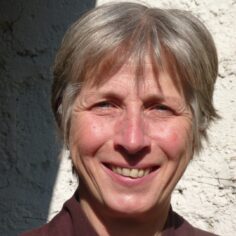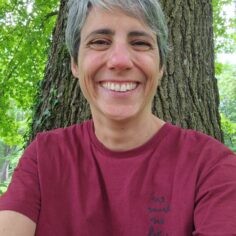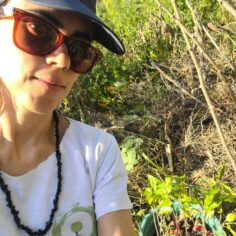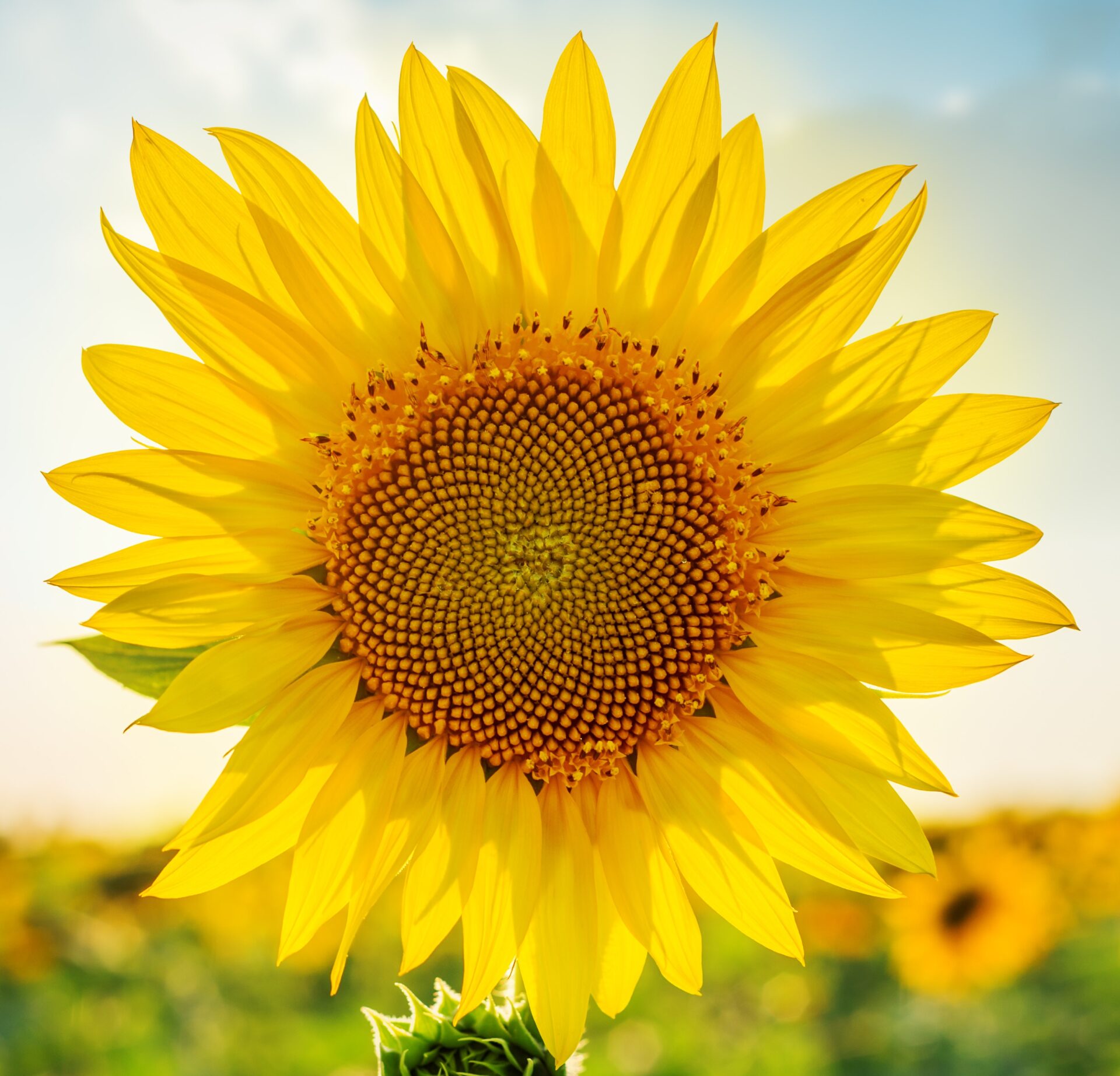Members of the Care-Taking Councils of the Earth Holder Community, the Abrazadores de la Tierra (Spanish-speaking EHC), and the Gardien.nes de la Terre (French EHC) share their experiences of nonduality in their daily mindful activism.
By Carolina León Rolón, Chantal Carrara, Daniela Simm, Isa Salinier, Laurène Girin, Leïla Denis, Maíra Fernandes de Melo on
Members of the Care-Taking Councils of the Earth Holder Community, the Abrazadores de la Tierra (Spanish-speaking EHC), and the Gardien.nes de la Terre (French EHC) share their experiences of nonduality in their daily mindful activism.
By Carolina León Rolón, Chantal Carrara, Daniela Simm, Isa Salinier, Laurène Girin, Leïla Denis, Maíra Fernandes de Melo on
Maíra Fernandes de Melo (Brazil, EHC/Abrazadores de la Tierra)
I was in my graduate studies and had been attending the Sangha in Rio for a few months. One day, I was having lunch in the university canteen, which was operated by a multinational food company that my dualistic mind would definitely label as “bad.” I had been diligently practicing eating meditation, and eating by myself in that context made me realize I was interconnected not only to the sun and the sky, but also to the “greedy” landowners involved in feeding me in that very moment. I can tell you that this was a hard insight for a beginner.
Eight years later, this past season, I was blessed with the opportunity to go to the Rains Retreat in New Hamlet, Plum Village, France. Among many moments of deep practice and shared joy, being able to breathe the same air as our beloved teacher, Sister Chân Không (True Emptiness), was of course the best. On one lazy Monday, she offered us a surprise: an unscheduled session of touching the earth! When I got to the big hall, almost all the long-term retreatants were already there, but aware of my deep devotion to her, my friends had left the mat closest to Sister Chân Không open for me. So there I was, honoring the French land ancestors as she guided us through the connection with everything around us: “I see that I am the blue sky above me; I am the air being polluted and the one that pollutes it; I am the leaves, the caterpillar, and the bird; I am one with the food from our Happy Farm and also the food from other farms, and I am the pesticide …” – Wait, what??? I don’t remember this part from the Plum Village App version—I AM THE PESTICIDE?

In the previous year, pesticide use had been a frequent topic in my activism; Brazil had started using hundreds of new synthetic agrotoxins after being forbidden in Europe and the United States. So, eight years after I experienced my “Sodexo insight,” every day more and more aware of what I was eating in my own quest to compassionately defund those I may have perceived as “greedy landowners that steal people’s lands and poison the Earth,” I received a new teaching on transcending discrimination, a question directly from the voice of Emptiness: How am I the landowner? How am I the pesticide? Many times in the agroindustry, pesticides are euphemistically called “defensives.” So for me it’s interesting to observe the situations when—with the excuse of defending myself and others—I can be the poison itself, through my actions of body, speech, and especially mind. This kind of deep looking encourages me to be more diligent in my practice of loving the Earth and all of her beings—if not with complete nondiscrimination, at least with less discrimination.
Daniela Simm (Germany, Abrazadores de la Tierra)
Loving all beings on this precious planet with no discrimination allows me to see how interwoven all of our problems are. We cannot separate war and conflict from exploitation of natural resources and destruction of ecosystems. We cannot separate social injustice between the Global South and the Global North and within our countries from the effects and root causes of climate change. The understanding of this interrelationship helps me to be motivated and engaged wholeheartedly in all aspects of what I do or don’t do in my life. We will make a change only when weaving our efforts together as a Mahasangha of all beliefs, all religions, and all aspirations.
I have learned that for me to be a wholeheartedly present and aware person, I must remember that all aspects of and in my life are interrelated. Being a mother, a spouse, an employee of a humanitarian organization, or a person sitting on the bus, doing housework, or going grocery shopping—these things are not separated from my Sangha, Earth holding, and activist life. It is not only the interrelationship between my little self and all of what is on this precious Earth that matters; I also have to be a coherent and inter-person.

When preparing a climate-change-related “medit-action” for a German audience, I have to keep in mind the horrible conflicts in the Global South, such as the many people displaced, killed, and suffering gender-based violence in countries such as the Democratic Republic of Congo. Knowing that conflicts around resources enable the beautiful and easy life of many people in the Global North, as well as the lives of the privileged in the Global South. Additionally, we should consider enabling the participation of a colleague from a partner organization in the Democratic Republic of Congo in our activities in Europe, exchanging knowledge with them so that their topics are heard and interpreted according to what we can digest and understand as Europeans.
Being an Abrazadora de la Tierra enables me to interrelate my Earth-holding activities in Germany with a wider Spanish-speaking Sangha whose people are rooted in other cultural backgrounds and who thereby may reflect on the roots of our global systems in another way so that I may transmit these realities to my siblings in Germany.
Leïla Denis (France, Gardien.nes de la Terre)
One practice that helps me contemplate nonduality is a practice with impermanence received from Sister Giác Nghiêm during a weekend at La Maison de l’Inspir. It’s about becoming aware of impermanence in all the little actions of everyday life. I’ve incorporated it into my morning practice. When I get to the door of the room where I’m meditating, I stop and say to myself: “My feet were shod, now they’re bare: impermanence. The door was closed, now it’s open: impermanence. The room was dark, now it’s lit: impermanence.” With each step towards the window, it’s impermanence that keeps me walking. And it’s impermanence that every morning offers me the gift of fresh air, new sunshine, birdsong emerging from silence, a bud, or a quiver in the branches. Sister Giác Nghiêm suggested we simply practice this every day for at least three weeks. No thought, no concept. Just a practical experience and profound observation: everything is woven of impermanence. Impermanence reveals to me its shimmer, the infinite flowering of its gifts. I tame death and loss. I learn to open my hand.
With Gardien.nes de la Terre, this teaching unfolds. Sometimes one of us is tired or less available. Their investment becomes less present. But does that mean they have disappeared? No. Nothing is lost, nothing is created, everything is transformed. We are a great body that continues its life through a thousand little deaths. My action is beautiful because it’s part of this stream of continuation. Who knows which ancestor is rejoicing with us right now? Who knows which distant descendant will sit in peace thanks to our combined actions? And who knows how all these movements currently at work around the planet are connected, feeding and healing each other without even thinking about it?
Carolina León Rolón (Argentina, Abrazadores de la Tierra)
Each day as a teacher, I have the opportunity to listen to the bell of awakening in the form of interactions with my secondary school students and colleagues. The dominant, inherited dualistic views and hierarchical narratives that condition schools need to be transformed as part of the systemic change necessary for us humans as a collective to continue our existence as beings of Mother Earth.
Every being of the Earth and of the Cosmos contributes to the nourishment of many other beings indiscriminately. How can we inter-be in the classroom like beings inter-are in the jungle, up in the mountains, deep in the wide ocean, along the mighty rivers, or across the Milky Way? How can the classroom be an environment where the vitality of the collective is a testimony of flourishing diversity? All the above are variations of one question that lies deep in my practice and ignites it: How can the classroom be a community where one can take refuge and enjoy inner freedom, happiness, and peace?
I imagine the answer that Thầy might give me if I had the opportunity to ask him how to escape the inherent dynamics of our educational systems: “The classroom of the future is already in the present moment.” That is why I can be certain that I don’t have to wait for an external transformation. Every group of students incarnates the opportunity to build a community where our actions are moved by understanding, compassion, solidarity, and love. It takes time; our old inherited habits are deeply rooted, even if we are children. But gradually, as a group, we begin to feel it is acceptable and preferable to be relaxed during the class, to remember we do not have to rush to do a lot of tasks, and that real joy and friendship emerge in cooperation rather than in competition—it is beautiful to be ourselves, and our nuances can be recognized and celebrated as nourishing to the collective. It takes time and requires patience; as with any other skill we learn, we have to renew our practice with every in-breath and every out-breath.
I wrote a paragraph to inspire myself when oblivion approaches, to train myself as a schoolteacher:
Aware of the suffering caused by a teaching practice that is in any way discriminatory, self-centered, not understanding, apathetic, indifferent, destructive, or violent, I am committed to promoting mindful interactions with and among my students. I am committed to looking deeply to recognize the suffering that lies in any violent behavior, listening deeply to recognize the true volition and necessities of my students, and speaking with truth and love to nourish with joy the capacity for wonder, learning, and creativity of my students. I am committed to training myself to come back to the present moment to recognize the conditions for happiness that surround us and can contribute to building a classroom where teaching and learning can occur in an atmosphere of solidarity, compassion, and peace and where we can learn from Mother Earth, our teacher of loving kindness, how to inter-be in order to flourish beautifully as a diverse collective in the present moment for a happier future.
Chantal Carrara (France, Gardien.nes de la Terre)
In my personal practice, nonduality means I no longer let myself get caught up in my judgments. I see them as such, and therefore as misperceptions, and I clear the space through mindful breathing to open my consciousness. I see that it’s my fears, those of others, and those of the collective consciousness that inhabit me. So I take care of my fear by welcoming it until it fades and is transformed into trust. Sometimes this practice fragile, and I have to come back to it several times.
I’m more and more aware of nonduality: what this person does or says offends me. This person isn’t just that one thing; as I look deeper, I see their suffering, and my compassion is born. I am aware that our cultures, histories, personalities, and sensitivities can cause us to mishandle, shock, and misunderstand each other. As soon as I touch this perception, I look at it and let it teach me about myself and about the other, and open once again: there is welcoming, kindness, space, inclusion, and liberation.
As a result of this practice, at sixty-eight years old I’m more at peace than ever. The historical dimension certainly exists. But the ultimate dimension is also in my present moment, and I can let all the disturbances of history melt away in that moment.
Isa Salinier (France, Gardien.nes de la Terre)
I hear the rustling insects and wake up to the warmth of a spring morning. Insects are the most numerous and diverse creatures on our planet. We are currently witnessing a global decline in the number, density, and diversity of their populations. Without the insects, the world as we know it today would not exist; their ecological functions within ecosystems are countless—from pollination to recycling waste and nutrients. If there were no insects to pollinate them, most flowering plants would die out.
This observation arouses in me a sense of concern and fear about the future of our planet as well as feelings of injustice and horror at the suffering created by the appropriation and unbridled exploitation of animate and inanimate beings. All of this is associated with the illusion that we, as human beings, are separated from other species and from the Earth itself. On the other hand, I also know that connecting with these marvelous beings in the joy of observing them, vibrating with them, and interbeing with them is a source of balance and openness in my heart.
This experience of nonduality invites me to practice doing no harm, not killing, and actively protecting Mother Earth. It supports my commitments and my practices of caring for all living things in and around me, together with Gardien.nes de la Terre.
Laurène Girin (France, Gardien.nes de la Terre)
In my personal practice, I try to see life and every living being as a wonder, with the curiosity of discovery.
I try to see and live every situation as an opportunity to learn, and to learn playfully with the joy of discovery.

For more information about the Earth Holder Communities, visit earthholder.training, gardiensdelaterre.earth, and Abrazadores de la Tierra on Facebook or YouTube.








